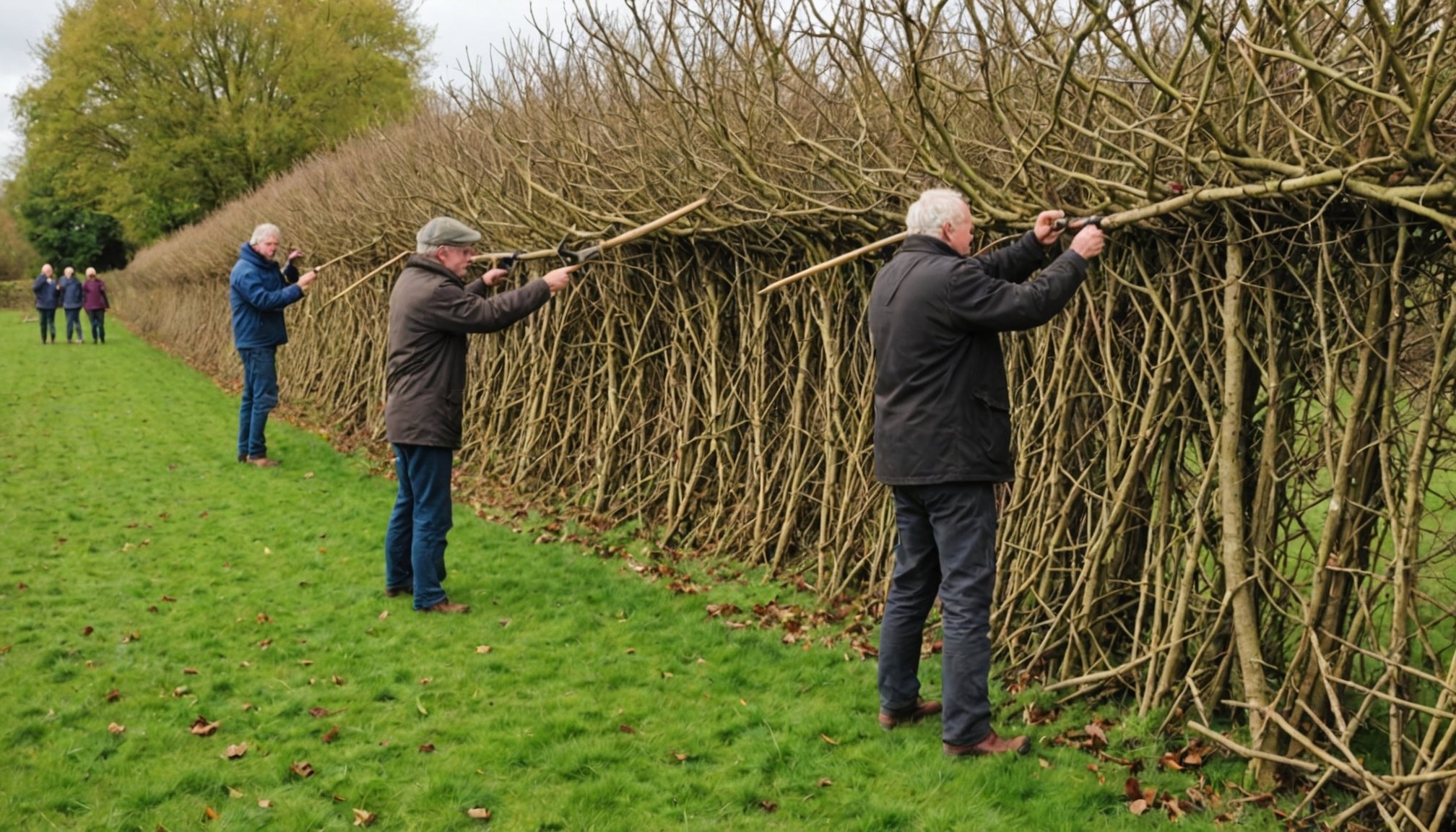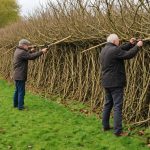Overview of English Hedgelaying Techniques
Hedgelaying is a traditional craft that dates back centuries, playing a critical role in shaping the English countryside. Its significance lies not only in its aesthetic contributions but also in its ecological and agricultural benefits. This ancient craft involves various techniques, enabling hedges to serve as effective boundaries, windbreaks, and wildlife habitats.
Different styles of hedgelaying have emerged over time, each unique to specific regions. For instance, the Midland style is notable for its neatly woven appearance, making it both functional and visually appealing. Meanwhile, the South of England style is characterised by its strength and durability, often used in more exposed landscapes. The selection of a particular technique depends on the hedge’s purpose and the regional landscape.
Also read : Discover Guided Tours Exploring the Rich History of the UK”s Iconic Marketplaces!
Learning these hedgelaying techniques can offer numerous advantages, particularly for conservationists and farmers. Well-laid hedges boost biodiversity, providing essential habitats for various species. They also help in soil retention and water management, critical factors for sustainable farming practices. Enhancing these skills not only preserves a traditional craft but also supports modern environmental and agricultural needs, creating a harmonious balance between nature and human activity.
Top Locations to Learn Hedgelaying in the UK
Location 1: Oakfield’s Hedgelaying School
Oakfield’s Hedgelaying School is renowned for offering some of the best courses in the UK. The school boasts state-of-the-art facilities, ensuring a comfortable and effective learning environment. The instructors at Oakfield’s are highly experienced with numerous certifications, providing quality guidance for learners. Regular workshops are held, catering to different skill levels. To register, visit their website for upcoming workshop dates and availability.
Also to see : Discover the Heart of Scottish Heritage: Best Spots for Traditional Storytelling in the Highlands
Location 2: Greenwoods Rural Workshop
Distinctive for its beautiful setting, Greenwoods Rural Workshop offers a unique learning experience. Its workshops are designed to accommodate both beginners and more advanced learners, ensuring a tailored approach to skill development. Testimonials praise the friendly atmosphere and thorough instruction. Current and past participants often highlight the workshop’s balance between practical learning and theory. Registration details and upcoming courses can be found online.
Location 3: Willowbank Community Event
At Willowbank Community Event, hedgelaying is more than a skill; it’s a community tradition. The event is deeply rooted in local history, fostering an engaging environment for learners of all levels. Throughout the year, several types of workshops are offered, ensuring there’s something for everyone. Accessibility is a priority, with accommodations available for various needs. For a detailed schedule of events, check their community board or website.
Learning Opportunities and Prerequisites
Traditional hedgelaying workshops offer an immersive learning environment where participants can acquire specific skills crucial to the craft. These workshops typically cover techniques such as tool handling, hedge plant selection and understanding hedge structures. You’ll also learn the art of cutting, bending, and weaving branches to create sturdy, living boundaries.
Prerequisites for Participation
While many workshops are accessible to beginners, some foundational skills or knowledge, such as basic gardening or landscaping experience, can be advantageous. Participants should ideally come prepared with a keen interest in manual labour and outdoor activities. An understanding of the prerequisites can facilitate a more rewarding learning experience.
Resources for Continued Learning
For those eager to expand their expertise beyond formal workshops, numerous resources are available. Books, online tutorials, and community groups offer varied insights into hedgelaying techniques. Engaging with local hedge conservation groups can provide practical learning opportunities and access to experienced mentors.
Many regions host hedgelaying competitions, which not only showcase craftsmanship but also offer participants a chance to observe, learn, and hone their skills in a supportive environment. These resources collectively ensure that learners can continue to develop their skills in the art of hedgelaying.
Expert Instructors and Their Contributions
In the realm of Education and traditional crafts, Expert Instructors play a pivotal role, imparting knowledge and preserving enduring skills.
Profile of Notable Instructor 1
With an extensive background in hedgelaying, this instructor has significantly contributed to the craft. Their experience is not only rooted in personal expertise but also in fostering community engagement. By actively involving local groups and enthusiasts, they have ensured the survival and growth of this traditional technique. Their dedication has strengthened community ties and inspired a generation of hedgelaying aficionados.
Profile of Notable Instructor 2
Renowned for their unique teaching methods, this instructor captivates students with a blend of modern and traditional techniques. Their classroom is a dynamic environment where hands-on learning is emphasised, promoting active engagement and deep understanding. Boasting several notable achievements and certifications, they have become a pillar in the educational landscape, admired for their commitment to student success and innovation in technique.
Profile of Notable Instructor 3
This instructor leads acclaimed workshops, receiving enthusiastic feedback from participants who appreciate the hands-on approach and thorough expertise shared. Through numerous initiatives, they have spotlighted the importance of traditional techniques, advocating for their preservation and appreciation. Their workshops go beyond skill-building; they cultivate a deeper appreciation for the craft’s history and relevance, bolstering its future within the community.
Resources for Further Exploration
To dive deeper into the world of hedgelaying, enthusiasts can begin by exploring a variety of additional resources. Engaging with online platforms such as forums and social media groups dedicated to hedgelaying can offer support and collaboration, as these communities often share insights, experiences, and practical advice. You might find interesting discussions where both novices and seasoned experts exchange techniques and problem-solving strategies.
For those seeking a more structured learning experience, several books and publications provide thorough information on hedgelaying techniques, history, and environmental benefits. Titles from renowned authors or institutions may serve as excellent additional resources for gaining a comprehensive understanding of the craft.
Furthermore, getting involved with local hedgelaying groups and associations can be immensely beneficial. Many areas have specific hedgelaying organisations and conservation initiatives that conduct workshops, demonstrations, and training sessions. These associations are pivotal in promoting the tradition and fostering a community that supports sustainable practices. Joining such groups can provide hands-on learning opportunities and support in real-world settings, alongside those who share a passion for this age-old practice.
Exploring these options can significantly enhance one’s knowledge and skills in hedgelaying, while also contributing to conservation efforts and the preservation of biodiversity.










